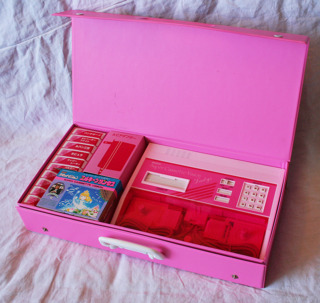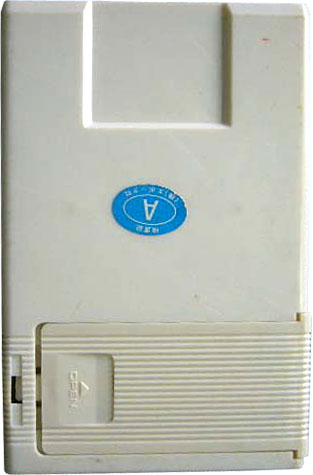Overview
 Lady Cassette Vision: Inside the Box.
Lady Cassette Vision: Inside the Box.The Super Cassette Vision is a game console released in 1984 by Japanese toy manufacturer Epoch. While the system was released in Japan as a follow-up to Epoch's previous effort, the Epoch Cassette Vision, it was also produced in Europe (primarily France) by ITMC under the name Yeno Super Cassette Vision. Aside from the Epoch Game Pocket Computer (which was also released in 1984) this would be the last system released by Epoch.
In 1985, Epoch released a version of the console in Japan squarely-aimed at the female market, named the Lady Cassette Vision, which was technically the same as the Super Cassette Vision but all components being pink in colour, came with a copy of Milky Princess, and was transportable inside a carry case which contained compartments for other cartridges, cables and power packs needed to operate the system.
Released at a price similar to the original (around 15,000 Yen), the Super Cassette Vision was largely unsuccessful in Japan due to the release of the Famicom the previous year, but managed to sell briefly in European markets before Nintendo's inevitable push into the territory in 1986, quickly outselling it and forcing it off the market.
The Super Cassette Vision sold 300,000 units in Japan, the same as the Epoch Cassette Vision.
System
 Battery-powered memory.
Battery-powered memory.The Super Cassette Vision features a built-in compartment on the front of the machine, used to house the controllers used in the system. The lid for this compartment also has convenient holes for the cables to run through so the lid may be closed while the system is being used. The controllers are hard-wired to the console, with a cable length of around 3 feet, featuring a similar joystick to the Epoch Cassette Vision, with two fire buttons on each shoulder of the controller. Each controller is labelled with a colored sticker (red/blue) to denote each player.
 The test screen.
The test screen.The system has the regular power buttons (On/Off Switch and Reset) and a Pause button on top of the machine, as well as a numeric keypad for other inputs. Game cartridges are brightly colored, coming in slotted cardboard boxes with manuals. The system was also the first to utilize cartridges with small battery-powered memory for saving high scores and user-made levels. These cartridges were often taller than normal, constructed to fit the extra components.
The Super Cassette Vision uses the standard RF connection for video output, but notably rare for system at the time was the native RGB output, which is controlled on the back of the system with a switch denoting RGB and RF channels.
When turned on without a cartridge, the Super Cassette Vision displays a 'video image test display', showing many single-colored balloons moving randomly around the screen while the background changes, an attempt to demonstrate the 128 sprite capabilities, a fact displayed on the packaging of system.
Games
30 games were available for the system in Japan, with 16 of those reaching the European market. Stickers on the front of the cart contained controls for the game. The banding on the packaging was generally consistent with the color of the cartridge, and colors were same across all regions. Much like the original, games for the Super Cassette Vision are also numbered in the order of their release, but the European titles followed their own numbering system.
| Japanese Releases (with cartridge color) | European Releases |
|---|
- Astro Wars (red)
- Astro Wars II: Battle in Galaxy (blue)
- Super Golf (yellow)
- Super MahJong (black)
- Super Baseball (neon green)
- Punch Boy (orange)
- Elevator Fight (white)
- Lupin III
- Nebula (black)
- Wheelie Racer (red)
- Boulder Dash (sea blue)
- Miner 2049er (burgundy)
- Super Soccer (lime green)
- Comic Circus (aqua)
- Milky Princess (pink)
- Pop & Chips* (sea foam green)
- Kung Fu Road (light purple)
- Star Speeder (light blue)
- Ton Ton Ball (light pink)
- Super Professor (yellow)
- Japanese Chess [Shogi] (golden brown)
- Doraemon (light blue)
- Super Basic* (white)
- Dragon Slayer* (sea green)
- Professional Wrestling
- Monster Land
- Dragon Ball (light blue)
- Mappy (lime green)
- Sky Kid (salmon)
- Pole Position II (light blue)
| - Astro Wars
- Astro Wars II: Battle in Galaxy
- Super Golf
- Punchy Boy
- Elevator Fight
- Lupin III
- Nebula
- Wheelie Racer
- Miner 2049er
- Boulder Dash
- Super Soccer
- Comic Circus
- Pop & Chips*
- Kung Fu Road
- Star Speeder
- Ton Ton Ball
|
* denotes powered RAM title
Technical Specifications
- CPU: 8-bit NEC uPD7801G (4MHz)
- Sound Processor: uPD1771C
- Sound: 1 channel (Tone, Noise or 1bit PCM)
- Display: 256 pixels x 256 pixels
- Video Processor: EPOCH TV-1
- Colours: 16
- Sprites: 128
- RAM: 128B
- VRAM: 4KB (2 x uPD4016C-2) + 2KB (EPOCH TV-1 internal)
- Controllers: 2 x hard-wired joysticks, built-in numeric keypad
- Power Supply: 8.5V DC External
Log in to comment